#palm leaf manuscript
Photo

#WordyWednesday
Palm leaf book: A book made of palm leaves. Palm leaf books were common in India and Southeast Asia: the leaves were trimmed, flattened, and polished smooth with sand, after which holes were drilled into the leaves and the resulting stack could be bound together with a cord or rod. Palm leaf books were protected by wooden covers. Tibetan books, although they are now written on paper, still mimic the distinctive shape of palm leaves.
Image: Javanese palm leaf book
(via Page — Pulpboard · Rare Books: A Glossary · Special Collections and Archives)
#wordy wednesday#wordywednesday#john henry#special collections#specialcollections#rare books#rarebooks#bookhistory#bookbinding#palm leaf manuscript#marbling#marbled#marbled paper#limp binding#vellum binding#ligature#typography
26 notes
·
View notes
Text
Episode 16: Alex West on the poetry of ascetics, Sundanese, and palm leaf manuscript culture

A leaf from Bodleian Library MS Jav. b.3. (R), a manuscript from Indonesia written on palm leaves.
In Episode 16 of Inside My Favorite Manuscript, Dot sits down with Alex West to talk about Bodleian Library MS Jav. b.3. (R), the only surviving copy of the Sundanese poem Bujangga Manik (written ca. 1470-1500). We start with the story, a tale of an ascetic who travels around the island of Java searching for spiritual transcendence, and along the way we discuss the manuscript, religious, and artistic cultures that formed the poem.
Listen here, or wherever you find your podcasts.
Below the cut are more photos and links relevant to the conversation.
Bodleian Library MS Jav. b.3. (R) (digitized online)
Wikipedia page for the poem Bujangga Manik (out of date)
Where is Java?


The wooden box MS Jav. b.3. (R) is stored in:

Folio 7r, a representative view of the appearance of the palm leaf pages. Note the large hole in the center of the page and two smaller ones on the edges - string originally would have been thread through the holes, to hold the leaves together and to enable them to fan out. The text is inscribed, with no ink.

A close-up of the center of 7r, so you can better see the inscribed writing.
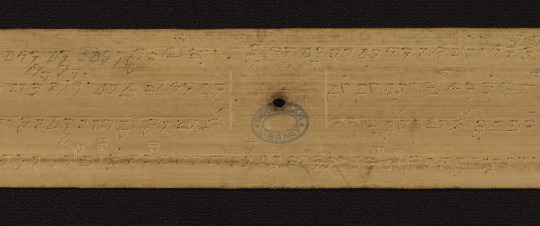
Folio 7v, the other side of 7r.

Dot misspoke during the podcast - the University of Pennsylvania palm leaf manuscripts are from India, not Thailand (the Thai manuscripts are written on paper). Here is one of them, Ms. Coll. 390 Item 82, Āhnikaprayoga, a digest of Hindu rituals from various sources written in 1822. In Sanskrit. Records here and here.
Front cover:

Folios 1v (top) and 2r (bottom)

An example of an inscription: The stone inscription of Kalasan, 778/779 ce, Central Java. National Museum of Indonesia, Jakarta, inv. no. D.147. Photo OD 7466, Kern Institute Collection, courtesy of Leiden University Library:

A. J. West, Bujangga Manik: or, Java in the fifteenth century: an edition and study of Oxford, Bodleian Library, MS. Jav. b. 3 (R). PhD Dissertation
Alex West's Medieval Indonesia on Medium.
Alex West on Patreon
#medieval#manuscript#inscription#palm leaf manuscript#sundanese#java#indonesia#southern hemisphere#asia#southeast asia#hemispheric middle ages#global middle ages#podcast#inside my favorite manuscript#imfmpod
33 notes
·
View notes
Text
gubat banwa 1e layout spoilers
because ive been working on this forever. also have a working spiel for gubat banwa:
SWORD AND ENLIGHTENMENT. LOVE AND GLORY. VIOLENCE AND LIBERATION.
Gubat Banwa is a postclassical-era fantasy martial arts Role-Playing Game, inspired by the refulgent cultures of Southeast Asia. Raise your spears, KADUNGGANAN, you elite warrior-braves and asura-knights who travel The Sword Isles to prove their conviction and dictate the fate of the world. Revel in larger-than-life war drama like in Asian Dramas, ballistic tactical martial arts grid gameplay in the vein of Lancer or Final Fantasy Tactics, and find glory beyond heaven. Wield the Thunderbolt of Liberation!



#gubat banwa#spoilers#yes they are made to look like palm leaf manuscripts and stone/copperplate/gold inscriptions#southeast asia#gamedev#ttrpg#rpg
12 notes
·
View notes
Text
Bangkok National Museum Showcases Ancient Thai Documents
Explore Thai history at Bangkok National Museum’s exhibition, featuring ancient inscriptions, legal documents, and historic maps from the Sukhothai era to modern times.
via Thai PBS, 11 April 2024: The Bangkok National Museum’s latest exhibition, “Precious Siam Inscriptions and Documents,” offers a deep dive into Thailand’s historical and cultural narrative through an extensive collection of artifacts. This includes nineteenth-century stone stelae, palm-leaf manuscripts, and early printed documents. Highlights include the Luang Prasoet Chronicle of Ayutthaya,…
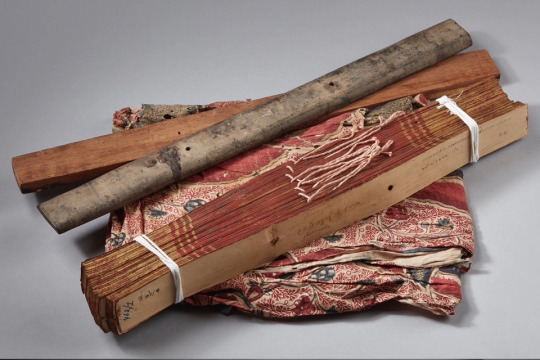
View On WordPress
#Bangkok (city)#Bangkok National Museum#documentary heritage#exhibitions#museums#palm-leaf manuscripts
0 notes
Text

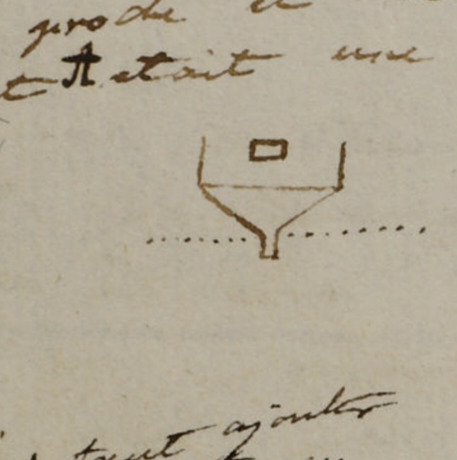
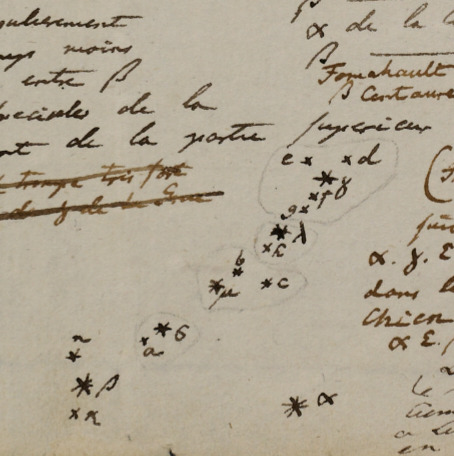
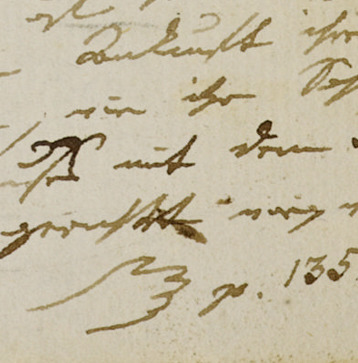



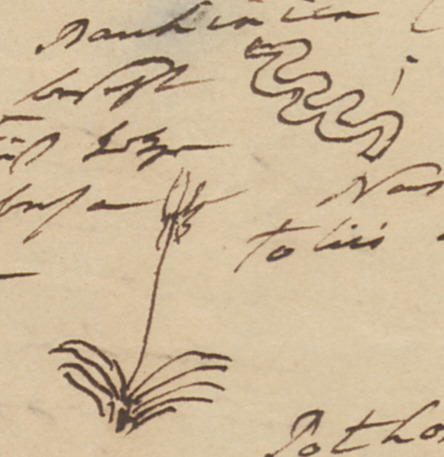
Some little doodles and drawings in Alexander von Humboldt's travel journals and other manuscripts
wax palms, 1830
mirrored image of a nearby tower, 1800
Grus star constellation, 1799
a manicule: a hand (literally) pointing to another page, 1799
compass needle doing compass needle things, 1799
a leaf, 1799
a palm tree, shrubbery and a cow that looks like a donkey appear to be floating in the air above the sea due to a mirage, 1799
grass and liana, 1830
#alexander von humboldt#alejandro#@marquisevonobst und ich sind übereingekommen dass wieder mehr alex-content auf tumblr benötigt wird#altersdurchschnitt der irl alex fanbase muss gesenkt werden!
29 notes
·
View notes
Text

This request is...old. like. Embarrassingly old to the point where I don't think the requester is even into ikevamp anymore- that old.
But. I wanted a small writing warm up while on my lunch break, so I whipped this up and the context of the ask is needed- so I took a screenshot so I wouldn't bother the person who asked, haha...
Short, unbeta'd since it's a request I'm using as a warm up, gets a little heated because while Mc might be innocent, Arthur is a pervert at heart (even if he's a sweetheart).
-----
This… was torture. Divine torture; pain that was worth bearing just to have you so close to him, but Gods, Arthur was suffering so.
You wiggled your hips as you settled in his lap, ignoring the wooden chair creaking as you leafed through the pages on his desk, "hm, you've written a lot today! Are you sure you're hitting writer's block, Arthur?"
He was hitting a block of some sort, right now… but he forced himself to ignore how cluelessly you were rubbing against his cock in your excitement to read his latest manuscript, trying to will the heat that was coiling deep in his abdomen away.
"I could feel myself getting there, luv! Those shackles creeping up to keep me here in agony, pouring over pages, trying to make sense of where to go next…!" he wrapped his arms around your middle, nuzzling your shoulder with a sigh. He hoped you couldn't hear the strain in his voice as he spoke, cutting down his theatrics, "...but as always, having my little dove with me soothes away any troubles I have."
Gods, your giggle would be the death of him. How could you be so darling, unintentionally riling him up, yet balming him with your gentle pats and letting him cling onto you so?
Arthur closed his eyes and breathed in your scent- the delicate perfume you wore mixed with the sweet smell of your blood that coursed through your veins. He could recall the day you started wearing this perfume: a date the two of you had gone on, where Arthur wouldn't take your humble declines for a gift again - why were you so stubborn about letting him spoil you? But eventually, you agreed as long as you could pick out a cologne for him in return.
Could you smell it on him now? When the wind blew through his open window, gently breezing through your locks?
Did the scent of him drive you up the wall in need, or did it simply comfort you?
For Arthur, the way you affected him as a whole depended on his mood. On some days he would feel his heart swell, and want nothing more than to bring you laughter and countless smiles. But on other days, something else would swell unbearably… and all he wanted to do on those days was greedily take kiss after kiss from you, swallowing every sweet, pleasurable mew his innocent little bird gave him as he showed you all the ways he could render you speechless-
"Oh!"
Arthur startled at your exclamation, eyes cracking open as he nearly broke out into a cold sweat. Was he reacting a bit too much with his daydreams?
But you simply nudged him for attention, pointing towards one of the lines he had written, completely unaware of how unbearable his growing erection was becoming underneath your plump rear.
"I don't think you often describe things like this, Arthur. I really like it, it helps visualize the story more and- eek!" Your cheeks turned bright red as he planted a kiss on your neck, your next words coming out in a stammer as you recovered from the surprise, "Arthur!"
"I'm sorry, luv," his palms moved to tease up your thighs, your skirt rising with the movement as even the tips of your ears burned with your blush, "but I have an entirely different problem I need your help with right now…"
-------
Masterlist | Ikevamp Server
205 notes
·
View notes
Text
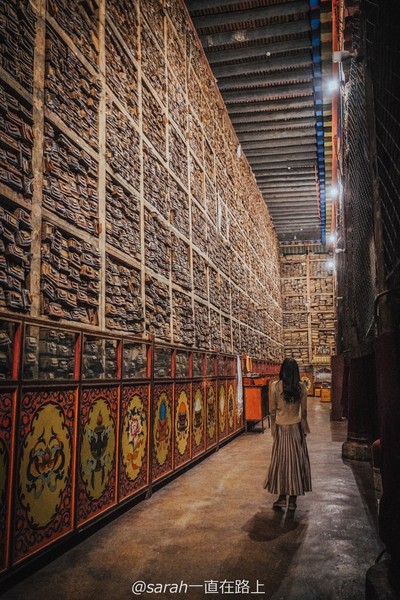
sakya monastery, tibet.
founded in 1073.
"Sakya Monastery houses a huge library of as many as 84,000 books on traditional stacks 60 metres long and 10 metres high. Most of them are Buddhist scriptures, although they also include works of literature, history, philosophy, astronomy, mathematics, agriculture and art. One scripture weighs more than 500 kg, the heaviest in the world. The collection also includes many volumes of palm-leaf manuscripts, which are well-preserved due to the region's arid climate." (wikipedia)
source photo
61 notes
·
View notes
Text
Guest post by our Reading Room Attendant, Audrey Buhain.
This new year we processed something that is the first of its kind into our Special Collections: a palm leaf manuscript!
The production of palm leaf manuscripts was most common before mass printing methods were adopted throughout South and Southeast Asia, but their production continues to this day. They consist of literary, folkloric,…

View On WordPress
29 notes
·
View notes
Photo

Dancing Saraswati
Hoysaleswara temple, Halebidu, Karnataka
Halebid – also referred to as Halebidu, Dwarasamudra, Dorasamudra – was a major city prior to the 14th-century in Hoysala kingdom.It is now a small town in south Karnataka. The temple belongs to the Shaivism tradition of Hinduism.
Like major historic Hindu temple complexes on the Indian subcontinent, this temple reverentially includes legends and ideas of Vaishnavism and Shaktism traditions of Hinduism. It was built in the first half of 12th century. During the early 14th century, Halebidu temple site along with others were sacked, looted and much artwork was damaged (particularly nose/face, limbs, sexual organs) by Muslim invaders from northern India (Khilji dynasty and Tughlaq dynasty of Delhi Sultanate). The relief panels present legends from the Ramayana, the Mahabharata, the Bhagavata Purana and secular fables found in Sanskrit texts of Hinduism. Vedic deities such as Agni, Indra and Surya, various avatars of Vishnu, the Hindu goddesses such as Saraswati, Lakshmi avatars, Durga, Kali among others are presented.
The carving is three dimensional where the deep reliefs often emerge as statues with depth. Panels are continuous, with one perspective showing one part of the legend, a perpendicular perspective of the same column or wall or corner showing another part of the same legend. The carving material was soapstone.
Above: Sarasvati is typically shown seated and holding a musical instrument. She is, however, the goddess of knowledge and all arts in Hinduism. The reliefs at Hoysalesvara temple show her in many panel, some where she holds a musical instrument. Three panels show her dancing, in a classical Indian dance posture (all are damaged panels, two of these panels is better preserved, the third is badly damaged). In this better preserved panel, she has eight hands and she holds a pen, a palm leaf manuscript, tools of other arts as she dances.
📷 by Ms Sarah Welch (via wikipedia)
123 notes
·
View notes
Text
Historical writing practices in Thailand
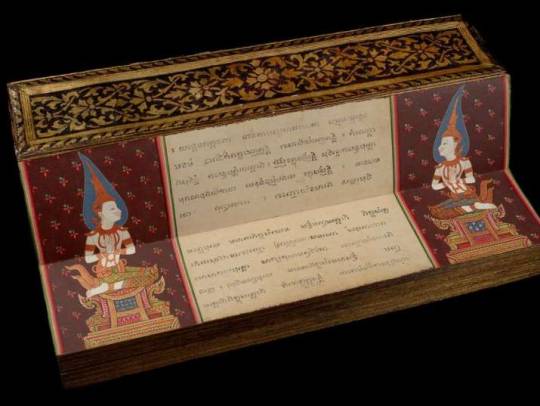
Thailand, along with other areas of Southeast Asia and India, traditionally used palm leaf manuscripts.
The individual palm leaves were first dried and a type of stylus / knife pen was used to inscribe the text. Natural colourings are then added to sit in the groves of the text and a clean cloth is then used to wipe off the extra colour.
In Thailand there were two ways the palm leaves were used.
The first involved individual thin strips of leaves which were punctured with holes and then threaded together with string.

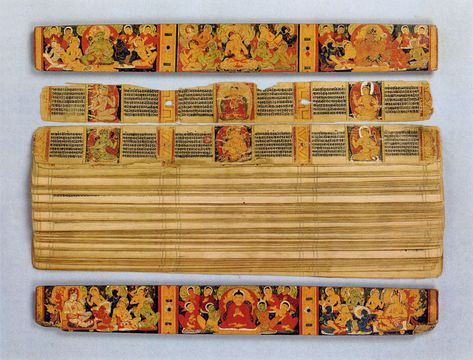

The second employed a style known as folding book manuscripts where a thick piece of paper, often made from the Siamese rough bush tree, was glued together in a long sheet.
This was then folded in concertina fashion with the front and back lacquered to protect the inside.
These unbound books can be found with white and black pages. Soot being used to darken the latter.
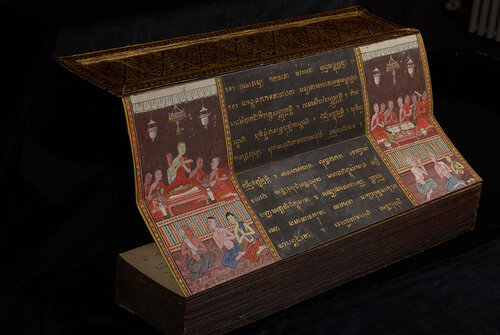



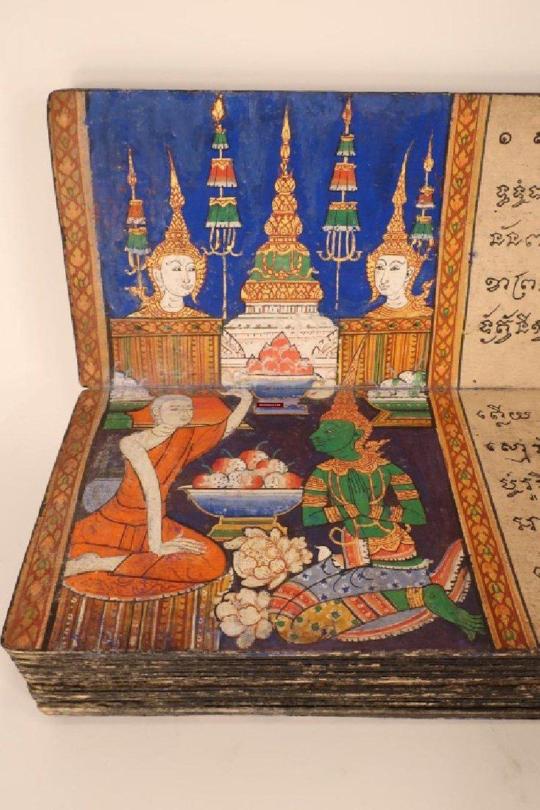

This technique was called samut khoi in Thailand and dates back to the Ayutthaya period (14th-18th centuries.)
Illustrated folding books were very popular in Buddhist monasteries and among royals and nobles.
#thai culture#historical writing#historical books#history#literature#beautiful books#man suang fic inspiration
6 notes
·
View notes
Text
A MUSE - Her long story
Saraswati (Sanskrit: सरस्वती), (pronounced sah RAS wah TEE) is the Hindu goddess of knowledge, music, art, speech, wisdom, and learning, all fruits of the intellect. She floats in sonorous music, highlighted by rustling silk and tinkling ornaments as she glides in serenity on her celestial Swan, stopping now and than in heavenly lotus pools. Her radiance, moonlike, promotes discernment, her calming smile fosters lucid reflection and creative inspiration. Her delicate long tapered fingers clasp a crystal rosary for She inspires sacred speech of every kind. She also holds a palm leaf manuscript for She grants fluency and elegance of expression to poets, scholars, playwrights, philosopher's and teachers.
What are Her anticidents and how did She evolve. The earliest literary evidence comes from the Rg-veda, so She was a Goddess in the Indo-European Aryan pantheon but some of Her characteristics probably were assimilated from a preexisting Goddess based culture.
In the Rg-veda, the close association between natural phenomena and such Vedic goddesses as Usas and Pṛthivi is also seen in the goddess Sarasvati, who is associated with a particular river. Although scholars have debated precisely which river she was identified with in Vedic times (the Sara svati River of that period has since disappeared), in the Rg-veda her most important characteristics are those of a particular mighty river. In deed, at times it is not clear whether a goddess or a river is being praised; many references hail the Sarasvati River as a mighty goddess.
Sarasvati is called mighty and powerful. Her waves are said to break down mountains, and her flood waters are described as roaring (Rg-veda - 6.61.2, 8). She is said to surpass all waters in greatness, to be ever active, and to be great among the great. She is said to be inexhaustible, having her source in the celestial ocean (7.95.1-2; 5.43.11). She is clearly no mere river but a heaven-sent stream that blesses the earth. Indeed, she is said to pervade the triple creation of earth, atmosphere, and the celestial regions (6.61.11-12).
She is praised for the fertility she brings the earth. She is praised or petitioned for wealth, vitality, children, nourishment, and immortality, and as such she is called subhaga (bountiful). As a fecund, bountiful presence, she is called mother, the best of mothers (2.41.16). As a nourishing, maternal goddess, she is described in terms similar to Prthivi: She quickens life, is the source of vigor and strength, and provides good luck and material well-being to those whom she blesses. In one particular hymn she is called upon by unmarried men who yearn for sons. They ask to enjoy her breast that is swollen with streams and to receive from her food and progeny (7.96.4-6; 1.164.49). She is sometimes petitioned for protection and in this aspect is called a sheltering tree (7.95.5) and an iron fort (7.95.1), neither image being particularly fluvial.
Sarasvati is also closely related to Vedic cult, both as a participant in or witness of the cult and as a guardian of the cult. She is invoked with and associated with the sacrificial goddesses Ida and Bhāratī and with the goddesses Mahi and Hotra, who are associated with prayer (7.37.11; 10.65.13). She is said to destroy those who revile the gods and to be a slayer of Vṛtra, a demon of chaos.
Sarasvati is described particularly as a purifying presence (1.3.10). Her waters cleanse poison from men (6.61.3). Along with rivers and floods in general, she cleanses her petitioners with holy oil and bears away defilements (10.17.10)
Anticipating her later nature as a goddess of inspiration, eloquence, and learning, the hymns of the Rg-veda also describe Sarasvati as the in citer of all pleasant songs, all gracious thought, and every pious thought (1.3.10-12). In this vein she is similar to the Vedic goddess Vac (speech), with whom she is consistently identified in the Brahmanas.
Sarasvati is one of the few important goddesses in the Vedas who remains significant in later Hinduism. In the Vedas her character and attributes are clearly associated with the mighty Sarasvati River. She is the earliest example of a goddess who is associated with a river in the Indian tradition. As a river goddess she is praised for her ability both to cleanse and to fertilize. Later Vedic literature (the Brahmanas) consistently associates her, even equates her, with the goddess of speech, Vac. Increasingly in her later history her association with a river is deemphasized and her association with speech, poetry, music, and culture in general is affirmed. In classical and medieval Hinduism Sarasvati is primarily a goddess of poetic inspiration and learning. She becomes associated with the creator god Brahma as either his daughter or wife. In this role she is creative sound, which lends to reality a peculiar and distinctive human dimension. She becomes identified with the dimension of reality that is best described as coherent intelligibility. Sarasvati to this day is worshiped throughout India and on her special day is worshiped by school children as the patron goddess of learning.
In the religion of the Vedic Aryans Sarasvati as the embodiment of the Sarasvati River is significant in that Vedic religon was primarily a portable religion. It centered around a fire cult that did not require permanent temples or places of worship. The domestic hearth itsel was a center of worship. By and large Vedic religion was appropriate for a nomadic life. In fact, as we know, the Aryans of the Vedas migrated into Northwest India as a nomadic people sometime during the second millennium B.C.E. and gradually spread South and East, undoubtedly encountering goddess centered religious culture.
Throughout the subcontinent in the course of many generations. The reverence given to Sarasvati as the embodiment of a river in Northwest India is important because it indicates that the Aryans had begun to identify their culture with a specific geographical location and were beginning to settle down to a non-nomadic way of life.
The transition from a nomadic to an agricultural, village culture is central in the transition from the religion of the Vedic Aryans to classical Hinduism. In classical Hinduism India herself is affirmed to be the center of the world, the navel of the earth, the special and sacred location of the divine. This is dramatically specified in the sacrality of many individual features of the Indian subcontinent, especially the sacredness of the major rivers of the land. The goddess Sarasvati, then, represents a very early example of this tendency in the Hindu tradition toward affirming the land itself as holy. The river goddess Sarasvati of the Vedas is a prototype of such important later river goddesses as Ganga and Jumnā.
The river goddess Sarasvati is also important in a theological or religious sense in that she suggests the sacrality inherent in rivers or water in general. While the symbolism of water is rich and complex in the religions of the world, two typical associations are important in Vedic descriptions of Sarasvati. First, she is said to bestow bounty, fertility, and riches. Her waters enrich the land so that it can produce. The waters of the river represent life itself in a dry environment, which Northwest India may have already been at the time of the Aryan migrations. Second, Sarasvati represents purity, as does water, particularly running water. Although this characteristic is rarely mentioned directly vis-à-vis Sarasvati, it is stated frequently in the Vedas that rituals were often performed on the banks of the Sarasvati, which were held to be especially sacred for ritual purposes. This probably suggests the purifying powers of the river.
Saravati's purifying power in the Vedic texts is also suggested in her association with medicine and healing. In the Satapatha-brahmana in particular she is called upon to heal sickness and is referred to as a healing, medicine. In the Rg-veda she and the Asvinas, twin gods often associated with healing, are said to heal the god Indra (10.131). As a divine physician, then, Sarasvati is petitioned to cleanse the petitioner of disease.
A particularly Indian association with rivers is the imagery of crossing from the world of ignorance or bondage to the far shore, which represents the world of enlightenment or freedom. The religious quest in all three native Indian religions-Hinduism, Jainism, and Buddhism is expressed by the metaphor of fording or crossing a wide stream. The river in this metaphor represents the state of transition, the period of rebirth, in which the spiritual sojourner undergoes a crucial metamorphosis. The river represents a great purifying power in which the pilgrim drowns his old self and is born anew, free and enlightened. This imagery expressly used in connection with Sarasvati in the Vedas, but it may have been understood implicitly and may help to explain the association of Sarasvati with inspiration, speech, and wisdom in her later history.
Although Sarasvati's nature and characteristics are overwhelmingly associated with a mighty river, this is no ordinary river. Early Vedic references make it clear that the Sarasvati River originates in heaven and flows down to the earth. This idea, also affirmed in the case of such important later river goddesses as Ganga, is a way of asserting the sacred nature of the rivers in question. The Sarasvati (and later the Ganga) represents an ever-flowing stream of celestial grace which purifies and fertilizes the earth. The earthly manifestation of Sarasvati as a river thus represents only a partial disclosure of her being. Physical contact with her earthly manifestation, however, connects one with the awesome, heavenly, transcendent dimension of the goddess and of reality in general.
The companion of the rippling brook, Saravati, and her connection with a river steadily decreases in later Hinduism. Although she continues to be associated with a river in some late sources," her characteristics and appearance increasingly bear little or no relation to a goddess who embodies the sacrality of a river.
As early as the Brahmanas Sarasvati is consistently identified with Vägdevi, the goddess of speech. It is not at all clear what intrinsic connection between Sarasvati and Vägdevi led to this association. Perhaps the centrality of sacred speech in Vedic cult and the importance of Vedic rituals being performed on the banks of the Sarasvati River led to the identification of the two goddesses. In any case, Sarasvati increasingly becomes a goddess associated with speech, learning, culture, and wisdom; most post-Vedic references to her do not even hint that at one time she was with a river.
In later Hinduism Sarasvati is sometimes said to have been born from the God Bhrama. Bhrama desiring to create the world goes into meditationon. Whereupon Brahma's body divides in two, half male and half female. Enraptured by his female half, who is Sarasvati, Brahma desires her, mates with her, and creates the demigod Manu, who subsequently creates the world." A similar version of her origin is found in the Brahma-vaivarta-purana and the Devi-bhagavata-purana. According to these texts, Krsna, who is identified with absolute reality (branman), divides himself into male and female, puruşa and prakṛti, spirit and matter, in order to proceed with creation. His female half takes on five forms or five saktis, dynamic powers, one of which is Sarasvati.' Reminding us of the five Dhyana Buddhas. Her specific creative function in relation to the other saktis is to pervade reality with insight, knowledge, and learning." In relation to prakrti she is said to be purely sattvic, spiritual. These same texts also describe Sarasvati's origin from the tip of Krsna's sakti's tongue. Suddenly, they say, a lovely girl appears dressed in yellow clothes, adorned with jewels, and carrying a book and a vina (lute)." Sarasvati is also often said to have her origin in and to reside in the mouths or on the tongues of the god Brahma (Brahma has four or five heads). That is, when Brahma undertakes the creation of the world through creative speech, the goddess Sarasvati is born in his mouths.
Sarasvati is also said to have had her origin from the god Visnu. In several places she is said to be his tongue or to be held in his mouth. Her association with Vişņu makes her the co-wife of Laksmi in many myths. In this relationship Sarasvati for the most part represents spiritual, ascetic, or religious goals and values, whereas Laksmi represents worldly well-being as manifest in wealth, material power, and fertility. In some texts the two goddesses do not get along very well, suggesting perhaps, a tension between bhukti (sensual enjoyment) or dharma and mukti (spiritual liberation or perfection) in Hinduism as we also see exemplified in the figure of Shiva.
Although Sarasvati's nature and appearance change dramatically from the Vedic period to later Hinduism as her association with a river decreases, she does maintain some characteristics of her earlier history. in a few cases even maintaining her association with a river.' She is associated, for example, with clouds, thunder, and rain and is said to be the presiding deity of rain. In the Vamana-purana she is described as moving through the clouds and producing rain (40.14)." The Vamana purana also identifies Sarasvati with all waters (40.14). Her association with Soma in some texts and with water in general suggests that Sarasvati is identified with the underlying sap of vitality necessary for all living things, that she nourishes life and promotes fertility. These continued associations with water, and sometimes with rivers, indicate a certain continuity between the river goddess of the Vedas and the later goddess. Even in reference to her association with waters, though, Sarasvati's character is much changed. In the later tradition she is not so much a river goddess as a goddess who manifests herself through the life-giving and purifying nature of all water: Tain, rivers, ponds, and so on. Like Soma she pervades creation; she has transcended her association with a specific river and now is more like life giving Mana.
Far more characteristic of the later Sarasvati is her association with speech. Even in the Rg-veda she is called impeller of true and sweet speech and awakener of happy and noble thoughts (6.61.9). Such as Vagdevi (goddess of speech), Jihvägravasini (dwelling in the front of the tongue), Kavijihvägrävasini (she who dwells on the tongues of the poets), Sabdavasini (she who dwells in sound), Vägisa (mistress of speech), and Mahāvāni (possessing great speech) are often used for Sarasvati. Her mythological identification with the tongues of Brahma, Krsna, and Vişņu also underlines her identification with speech or creative sound as music.
The importance of speech in Hinduism is both ancient and central. The entire creative process is held to be distilled in the syllable OM, and the idea of creation proceeding from sabda-brahman (ultimate reality in the form of sound) is often mentioned in Hindu texts, as it is in the Hebrew Bible. The potency of speech and sound is also seen in the centrality of mantras in Hinduism. A mantra, which may consist of words or of sounds alone, is held to possess great power. Indeed, the mantra of a given deity is declared to be equivalent to the deity itself. To pronounce a mantra is to make the deity present. The name of the deity and the deity itself are equivalent. There resides in sound a potent quality, and this quality is embodied in the goddess Sarasvati.
Speech is also important and revered because it permits communication between people. Speech, to a great extent, sets human beings apart from all animals. Speech is also associated with rationality and refinement. Speech represents coherent sound that permits the transmission of ideas, wisdom, and culture. As the embodiment of speech, then, Sarasvati is present wherever speech exists. And so it is that she is preeminently associated with the best in human culture: poetry, literature. sacred rituals, and rational communication between individuals.
Sarasvati is also identified with thought and intellect. Not only is she speech in the form of coherent sound, she is that which underlies or makes speech possible, namely, intelligence and thought. This association is indicated in such epithets for her as Smrtisakti (the power of memory), Jñañaśakti (the power of knowledge). Buddhisaktisvarupiņi (whose form is the power of intellect). Kalpanasakti (who is the power of forming ideas), and Pratibha (intelligence, or she who is intelligence). As thought and intellect, Sarasvati is thus identified with the distinctive ability that distinguishes human beings as special, reasoning. She represents the peculiar human ability to think, which is precisely the ability that has permitted human beings to create and imagine their innumerable cultural products, from cooking pots to philosophic systems. ther reinforces her nature as the goddess of speech and thought. Sarasvati's association with science, learning, and knowledge would make Her the goddess of mathematics and physics.
Sarasvati is also said to underlie, inspire, or embody the arts. She is said to provide inspiration to poets and to be present wherever artistic excellence is evident. Poets often praise her assistance or ask for her help. She is said to be associated with the Gandharvas, a supernatural race that excels at dancing," and she is often associated with music, both instrumental and vocal. In short, Sarasvati is manifest wherever human culture exists. Inspiring and embodying both the arts and sciences in human culture, she represents the greatness of human civilization in all its richness and diversity.
Beyond Sarasvati's associations with culture, which dominate her character, are certain cosmic associations or certain tendencies and epithets that suggest her primordial, absolute nature. Such names as the following identify Sarasvati as a great, universal goddess whose functions extend to the creation of the worlds: Jaganmātā (mother of the world), Saktirūpiņi (whose form is power or sakti), and Visvarupā (containing all forms within her). It is fairly easy to imagine how Sarasvati's character as the inspiration and embodiment of culture might lead to her assuming such cosmic characteristics. As the reality that permits human beings to achieve dominion over all other creatures, that permits or inspires the beauty and grace manifest in the arts, that has enabled human beings to achieve an almost godlike nature in the physical world as its masters and molders, this goddess of culture comes to be extolled or equated with the highest powers of the cosmos.
Sarasvati's iconography illustrates her associations with culture, particularly the arts and sciences, and shows her to be a goddess who is for the most part set apart from the natural realm of growth, fertility, blood, and other phenomena often associated with or central in the iconography and mythology of other goddesses. She is usually depicted as having four hands, and the most common items held by her are a book, a lute (vina), a rosary, and a water pot. The book associates her with the sciences and with learning in general. The lute associates her with the arts, particularly the musical arts, and the rosary and the water pot associate her with the spiritual sciences and with religious rites.
The predominant themes in Sarasvati's appearance are purity and transcendence. She is almost always said to be pure white like snow, the moon, or the kunda flower" or to shine brilliantly and whitely like in numerable moons." Her garments are said to be fiery in their purity, or they are described as white, and she is sometimes said to be smeared with sandalwood paste." Sarasvati's gleaming white body and garments express well her purity and transcendence, and these themes are in keeping with her typical association with the sattva guna, the pure, spiritual thread of prakyti. Sarasvati is rarely described as having fearsome aspects" and is usually portrayed as calm and peaceful. These qualities are conveyed in the serene, white images of her in Hindu art."
Sarasvati's transcendent nature, which removes her from the impurities of the natural world and its rhythms of growth and fertility, is also suggested in her vehicle, the swan. The swan is a symbol of spiritual transcendence and perfection in Hinduism. Spiritual masters and heroes are sometimes called supreme swans (paramahamsa) in that they have completely transcended the limitations and imperfections of the phenomenal world. Sarasvati, astride her swan, suggests a dimension of human existence that rises above the physical, natural world. Her realm is one of beauty, perfection, and grace; it is a realm created by artistic inspiration, philosophic insight, and accumulated knowledge, which have enabled human beings to so refine their natural world that they have been able to transcend its limitations. Sarasvati astride her swan beckons human beings to continued cultural creation and civilized perfection.
Sarasvati is also typically shown seated on a lotus. Like the swan, the lotus seat of the goddess suggests her transcendence of the physical world. She floats above the muddy imperfections of the physical world, unsullied, pure, beautiful. Although rooted in the mud (like man rooted in the physical world), the lotus perfects itself in a blossom that has transcended the mud. Sarasvati inspires people to live in such a way that they may transcend their physical limitations through the ongoing creation of culture.
The benefits to be derived from the worship of Sarasvati, of the blessings that she is expected to bestow on her devotees, usually relate to the themes that we have noted as central to her character. She gives eloquence, wisdom, poetic inspiration, and artistic skill. She removes speech defects and dumbness and grants charming speech and a musical voice. Although she is sometimes said to grant wealth, long life, worldly enjoyments, and final salvation, she is primarily the goddess of wisdom and learning and specializes in promoting success among philosophers. scholars, and artists, who are her special devotees.
A persistent theme in the Hindu tradition is that human destiny involves the refinement of nature. Although the ultimate goal of the religious quest may be moksa, the complete release from the phenomenal world, Hindus affirm that being fully human necessitates molding, enhancing, and refining the natural world in order to make it habitable for human beings. Such important Hindu ideas as dharma, the samskaras (life-cycle rituals), and the varna-jati (caste) system all suggest this emphasis. The arts and sciences, however, seem to be the most obvious and concrete manifestations of this theme in the Hindu tradition. Artistic creation and the accumulated knowledge of the sciences, including philosophy, epitomize human culture and demonstrate the extraordinary ability of human beings to mold and refine the natural world into something beautiful and specially human. Sarasvati presides over and inspires this dimension of being human in the Hindu tradition.
Many goddesses both within and outside the Hindu tradition gain their immense vitality and popularity through their associations with certain aspects of the natural world. Fertility, sexuality, growth, blood, and the sap of life in general seem to be embodied in many goddesses. Hinduism also attributes great power to goddesses. They are typically referred to as saktis (powers), and several Hindu goddesses are particularly adept at warfare and are most at home on the battlefield. Several other Hindu goddesses seem to be particularly popular among women and to specialize in family and domestic blessings. Many goddesses provide models for the most significant female roles in Hindu culture, or at least they participate in these roles, albeit in ways that do not always conform to dharmic models. Sarasvati has very few of these associations. Her pure, milky-white appearance and completely sattvic nature dissociate her from the mud of existence, from the vigorous, fecund sap of fertility. Her sexual encounters are not emphasized, and when her father/husband Brahma does desire her, she seeks to flee from him. Her motherhood is usually only metaphorical: she is said to give birth to artistic creations by providing inspiration or to have given birth to the Vedas in the sense that she personifies wisdom. In the Devi-bhagavata purana she is said to be ascetic in nature and to grant boons to those who perform asceticism (9.1.35). Her presence is therefore not usually sought in the home. She is not a domestic goddess. Nor is her presence sought in the fields, where fertility is crucial, or in the forests and mountains, where isolation from culture is desired in the quest for mokṣa. Her presence is sought in libraries and schools, by those who create and bear
culture in the ongoing task of transforming the natural world into a refined and civilized habitation for human beings. Throughout North India today Sarasvati's special puja is celebrated in early Spring. On this special day images of the Goddess are placed in schools and universities in association with special cultural programs.
Sarasvati's association with the intellectual sphere assured that she would find favor among Buddhists, who highly value wisdom and its servants: mental clarity, reasoning ability, memorization, and oratorical skill. Sarasvati thus has an affinity with Prajñāpāramitā, the goddess of perfect wisdom. They may be invoked by the same mantra, reflecting the kinship between the wisdom goddess and the patroness of learning.
Speech is emphasized in the Tibetan translation of her name as Yangchenma, "Goddess of Melodious Voice." Buddhist texts acknowledge that she is worshipped by "all scholars in India, Hindus and Buddhists alike, without contention. The Karandavyuha (ca. sixth century), however, endows her with an explicitly Buddhist origin, holding that she emerged from the eyetooth of Avalokitesvara when different parts of his body gave rise to the Hindu gods.
There is little evidence of Buddhist worship of Sarasvati before the fourth century C.E. She apparently finds no mention in Pali literature, and her effigies are absent from the known corpus of early Buddhist art. A female figure playing a stringed instrument, carved on a Bhärhut railing pillar (second century B.C.E.), has been accepted by some as the earliest effigy of Sarasvati. This image, however, predates iconographic descriptions and other known images of the goddess by several centuries and thus appears to be a celestial musician (apsaras), a type of figure often described as rejoicing in the presence of the Buddha and his relics. The same is true of several lute-bearing females in the Gandharan repertoire (first and second centuries C.E.). Sarasvati finds passing mention in the Buddhacarita (second century C.E.) among Hindu deities who helped bring forth the Vedas, according her no special Buddhist significance or reverence.
The Golden Radiance Scripture (ca. late fourth or early fifth century) marks a transition in Buddhist conceptions of Sarasvati. Her name appears throughout the work among the pan-Indic, rather than specifically Buddhist, divinities whose blessings are promised to listeners and reciters of the text. The non Buddhist origin of Sarasvati is acknowledged by her inclusion in these passages, but she is favored with placement at or near the head of these lists as the "foremost" (pramukha) of the assembly and is repeatedly lauded as a "great goddess" (mahadevi and mahadevata)." Moreover, Sarasvati is the focus of one of the few chapters devoted to individual divinities. This portion of the work is the earliest known document of her explicit incorporation into the Buddhist pantheon, advancing her as an object of Buddhist invocation, ritual, and worship. She is praised as "supremely, extremely beautiful" and, among all divine females, as "the supreme, chief, excellent goddess," brilliant and of knowledge," "endowed with profound wisdom."
As the chapter opens, Sarasvati pays homage to the Buddha and promises that she will grace the preachers of the scripture with eloquence, oratorical power, perfect memory, inconceivable knowledge, penetrating wisdom, illumination, skill in liberating others, scholarly expertise in every field, proficiency in all the arts, merit, prosperity, and long life. Several Sarasvati mantras (termed dharani in the work) for different purposes are given in the chapter,
including a special recitation for memory retention. In the following mantra, translatable phrases alternate with syllables of evocatory power:
May my insight be unobstructed! May my knowledge prosper in text books, verses, magic books, doctrinal books, and poems! So be it: "Mahaprabbave hili hili mili mili." May it go forth for me by the power of the blessed goddess "Sarasvati! karate keyüre keyurabati hili mili hili mili bili bili."
The Golden Radiance Scripture outlines a role for Sarasvati that far exceeds begetting wisdom. The text proclaims that she frees her devotees from unfavorable planetary influences, human discord, nightmares, and persecution by supernatural beings, negative conditions that fall within her purview are disruptions to the tranquil harmonious environment necessary for intellectual and creative pursuits. These obstacles and adversities are to be removed by an elaborate ablution rite. More than thirty herbs and medicinal plants must be powdered, consecrated with mantras, and added to the purifying ablution water. A Sarasvati mandala is then constructed out of flowers, gold and silver vessels, mirrors, banners, and incense, to the accompaniment of five kinds of musical instruments. Sarasvati is to be envisioned in eight-armed form, but her attributes are not described. The goddess promises that she will appear at the ritual site and, in addition to the aforementioned benefits, remove "every disease from that village, city, district, or dwelling," so that all who reside there may gain relief from suffering and rapidly attain enlightenment.
Buddhist envisionments of Sarasvati took Hindu conceptions of the goddess as a point of departure. A favored Buddhist form, known as Vajravīnā, "Lady of the Adamantine Lute," is a white, two-armed epiphany in which she plays her supernal lute, or vina. The instrument is made of lapis lazuli and has a thousand strings capable of eliciting every musical note. Sarasvati's melodies pervade the universe and delight all types of beings in accordance with whatever is most pleasing to their ears. She sits with ankles crossed and knees raised in a distinctive posture suitable for balancing a musical instrument.
Writers expend themselves to describe the patroness of poesy with literary flourish, as seen in a passage from a Sakya meditation manual:
"On the tremulous corolla of a pure white lotus, sitting charmingly on a moon-disc with upraised knees... she strums a celestial lute, producing melodious sounds that satisfy the hearts of the diverse beings in the three white lotuses. Her hands and wrists are adorned with strands of jewels and tinkling bells. The sight of the youthful, enchanting goddess inspires wonder in all beings."
Another two-armed, white manifestation known as Maha-Sarasvati displays a white lotus (often supporting a book) and the gesture of divine blessing. She has a retinue of four goddesses, identical in appearance to herself, whose names reflect the gifts they bestow as her emanations: "Wisdom" (Prajñā), "Insight" (Mati). "Intelligence" (Medha), and "Recollection" (Smrti). This form of the goddess appears in the art of Nalanda and Ratnagiri. Additional two-armed, white forms are described in the Sadhanamala. Sarasvati may be depicted in a range of poses. The crossed-ankle utkutakasana posture is most characteristic, but she may appear in a cross-legged meditative posture, seated with one leg pendant, or standing in a variety of stances. A four-armed, white epiphany in the Sakya pantheon bears, along with a lotus and musical instrument, a sword of wisdom. Buddhist texts rarely mention Sarasvati's swan mount, but the bird may be included in artistic portrayals, adopting the Hindu convention. The swan may be shown as her vehicle, her companion, or even her downy footrest. Red forms of the goddess were introduced in the Buddhist pantheon. One two-armed form, actively practiced in Tibet, holds a wish-fulfilling gem in her right hand and a mirror of wisdom in her left. She is invoked to quicken intelligence, but the miraculous jewel, source of bounty, is present to offset the poverty often attendant on intellectual pursuits. A red, six-armed manifestation known as Vajra Sarasvati, attested in both India and Tibet, has Tantric attributes, such as a flaying knife and skull cup.
The most explicitly Tantric epiphany of Sarasvati is the red form in which she appears in union with her consort, Manjuśrī, a male embodiment of wisdom and thus a fitting counterpart for the knowledge-bestowing goddess. Both have four arms-two for embracing one another and two left free to hold their implements. Sarasvati strums her vina, filling the universe with an ocean of song, while Manjuśrī bears aloft his effulgent sword and a blue lotus supporting a Prajñāpāramitā text. As he sits on her lap, their legs intertwine amidst the petals of their lotus throne. Attended by Sarasvati's retinue of four goddesses, the divine couple is "wondrous to behold, adorned with arrays of jewels, seated within a glorious blaze of light."
In Tibet, the wrathful Dharma protector Palden Lhamo is sometimes regarded as a fierce emanation of Sarasvati. To express this relationship, the lute-playing goddess may float above Palden Lhamo in paintings of the latter." This association between divine protectress and muse, on surface a puzzling one, is traceable to Indic connections between Sarasvati and Durga, a Hindu warrior goddess. In Hindu mythology, Sarasvati is sometimes cast as the knowledge aspect or speech aspect of the battle queen Durga. In the Buddhist context, too, Sarasvati is linked with Durga in the Golden Radiance Scripture. Although this work makes no mention of Durga, its description of Sarasvati draws on liturgies and iconographic conceptions of Durga in her buffalo demon-slaying mode. Although the connection between Sarasvati and Durga is not a prominent theme in literature on either goddess, it is apparently one of many aspects of Durga that left a stamp on Palden Lhamo. Pictured various images of Sarasvati.





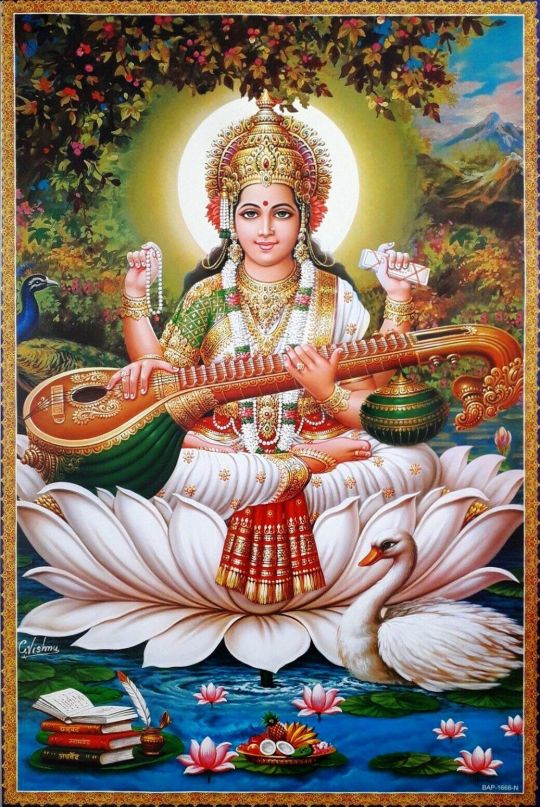

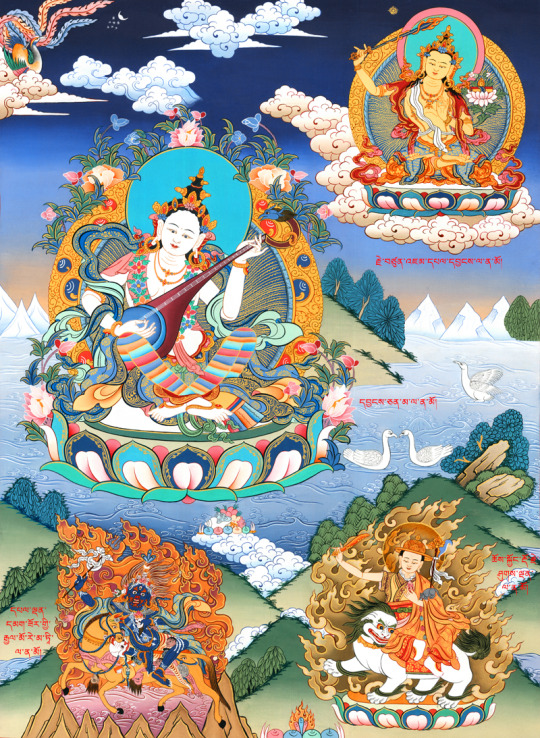


3 notes
·
View notes
Text
Nadi Jothida Nilayam in Vaitheeswaran Koil
Welcome to the Mahasivanadi’s mystical realm of Nadi Jothida Nilayam in Vaitheeswaran Koil, Tamil Nadu, where ancient wisdom meets modern seekers in an extraordinary journey of self-discovery. Nestled amidst the serene surroundings of this sacred town lies a treasure trove of palm leaf manuscripts, each holding the profound secrets of individual destinies.
Nadi Jothida Nilayam, or Nadi Astrology Center, serves as the custodian of these ancient manuscripts, which are believed to have been inscribed thousands of years ago by enlightened sages. These palm leaves, meticulously preserved over generations, offer glimpses into the karmic imprints and life paths of those who seek their guidance.
Visitors to Vaitheeswaran Koil embark on a spiritual pilgrimage, drawn by the allure of these mystical texts. Upon arrival at the Mahasivanadi Nadi Jothida Nilayam, seekers undergo a process of thumb impression analysis, where their unique imprint is matched with the corresponding palm leaf manuscript containing their personal destiny.
The revelations found within these ancient scrolls are astonishingly accurate, offering detailed insights into past events, present circumstances, and future possibilities. From familial lineage to career prospects, health concerns to relationship dynamics, the Nadi readings provide a comprehensive roadmap for navigating life's journey.
But perhaps most profoundly, Nadi Astrology transcends mere prediction, offering seekers an opportunity for profound self-reflection and spiritual growth. Through the guidance of the Nadi Jothida Nilayam, individuals gain clarity on their life's purpose, learn from past experiences, and empower themselves to make conscious choices that align with their highest destiny.
Vaitheeswaran Koil stands as a testament to the enduring power of ancient wisdom in the modern world. Here, amidst the tranquil surroundings and sacred rituals, seekers from all walks of life find solace, inspiration, and profound insights into the mysteries of existence. As the journey unfolds, each step taken in the footsteps of the sages brings one closer to the ultimate truth of their own divine nature.
#Nadi Jothidam#Best Nadi Astrology#Nadi Predictions#Nadi Jothyish#Arudam Nadi Astrology#Astrology centre#Nadi Jyotish in India#Nadi Astrology#Nadi Atrologer#Nadi astrologer#Nadi Astrology online#Online Nadi Astrology Services#Astrology Services#Best nadi astrology online
0 notes
Text
Palm leaf astrology
Unlock the secrets of your destiny with Palm Leaf Astrology! Our ancient palm leaf manuscripts hold personalized predictions about your life, career, and relationships. Experience the wisdom of the sages. Book your reading now!
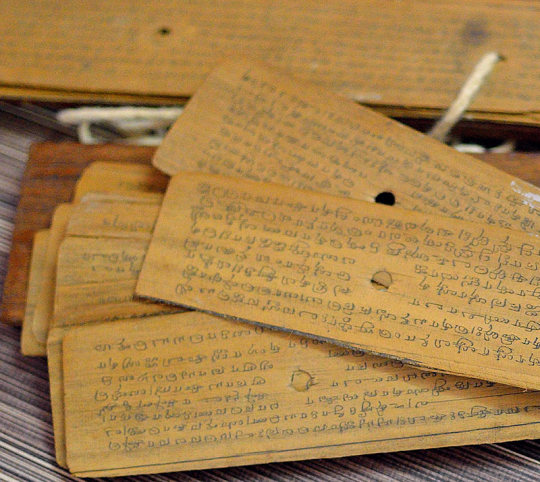
0 notes
Text
[Talk] Recalling a Trans-local Past: Thailand’s Mon-language Manuscripts
Readers may be interested in this talk by Dr Patrick McCormick on Mon manuscripts at the Siam Society on 16 May 2024.
Readers may be interested in this talk by Dr Patrick McCormick on Mon manuscripts at the Siam Society on 16 May 2024.
The Mon people are usually associated with Burma, yet Burma has never been the only place where Mon-speaking communities have lived. Large numbers of Mon-language manuscripts are kept in the temples of the Thai-Mon community, living largely in the provinces surrounding Bangkok.…

View On WordPress
#Bangkok (city)#documentary heritage#Mon (language)#Mon (people)#palm-leaf manuscripts#Siam Society#talks / presentations
0 notes
Text
Understanding Nadi Astrology:
Nadi Astrology, also known as Nadi Shastra, is an ancient form of astrology like vedic astrology believed to have originated in India thousands of years ago. It is based on the belief that the past, present, and future of every individual are written in palm leaf manuscripts called Nadi leaves. These leaves are said to have been inscribed by sages or seers who possessed divine insights into the destinies of people.
The process of Nadi Astrology begins with the identification of an individual’s Nadi leaf, which is determined based on thumb impressions. Each Nadi leaf is associated with a particular person and contains detailed information about their past, present, and future. A skilled Nadi Astrologer interprets the contents of the leaf to provide insights and predictions regarding various aspects of the individual’s life.
#astrology #nadiastrology
0 notes
Text
Established in 1851, the Government Museum of Chennai holds a significant place in India's cultural landscape. It boasts a diverse collection of over 1200 objects spanning various disciplines. These artifacts, palm-leaf manuscripts, and other objects are meticulously categorized into sections including geology, archaeology, zoology, anthropology, numismatics, botany, and sculpture.

0 notes